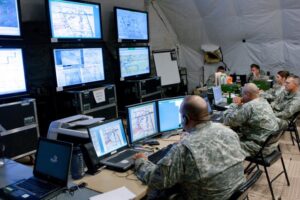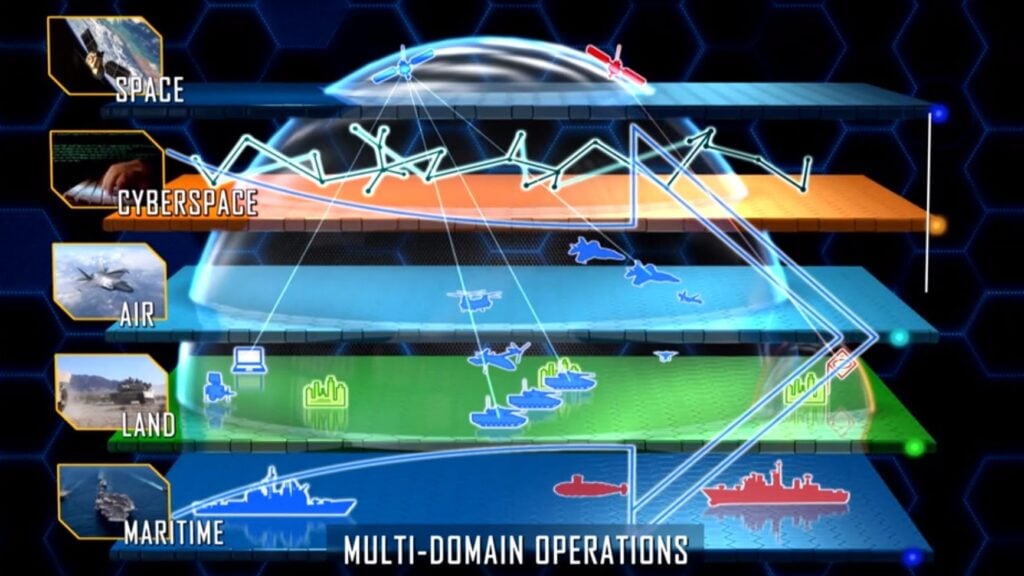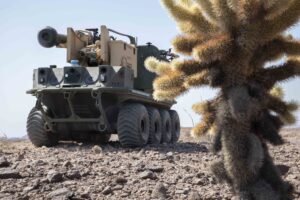
Army command post
While Project Convergence’s first big test, the Army’s “experiment at scale for a combined arms operations,” was deemed a great success, the service must resist the urge to scale-up so rapidly that the events lose their value as experiments or become a fat target for budget cutters.
The convergence tests, linking weapons, sensors, systems and techniques in new ways, ran from mid-August to mid-September at Yuma Proving Ground.
[Click here for our complete coverage of Project Convergence]
At the annual Association of the U.S. Army conference, then-Defense Secretary Mark Esper congratulated the Army on the experiment and pledged to make future iterations of the project bigger and better—bringing in other services and countries. Army Brig. Gen. Ross Coffman quickly issued a statement saying, “We’ve got to scale this at the joint level…; the Air Force, the Marines and the Navy have all committed to Project Convergence ’21…; the United Kingdom has agreed to participate and Australia is a maybe.”
The Army has already promised to add live troops acting as an enemy opposing force, electronic warfare to jam comms networks, and shots of the new Precision Strike Missile to next year’s Project Convergence. The year after that, it plans to add new organizations such as the Multi-Domain Task Force, Brigade Combat Teams, and Allied and Partner Mission Command elements.
If that were not enough, the Army has announced that Project Convergence will serve as its testbed for the high priority effort to connect with the Air Force’s Advanced Battle Management System—a major step toward the goal of Combined Joint All-Domain Command Control (JADC2), DOD’s “interconnected infrastructure.”
By all indications, praise for Project Convergence is warranted. The Army pulled the experiment together quickly [They only started discussing it eight months ago.], at relatively modest cost, and they came away with tangible insights.
But vastly increasing the size, cost, participants and the accompanying attention are not traditional hallmarks of a successful military experimentation program. History has proven that the more time, money, participants and in particular—attention—afforded an experiment, the greater the temptation to hijack the learning opportunity to less noble ends.
In these circumstances, experiments often become demonstrations; results become predetermined to avoid public embarrassment; and, taken to extreme, “campaigns of learning” devolve to mere shows crafted to build external support for proposed budget investments and earn favorable press mention.
Harold Gehman, a former commander of Joint Forces Command, (the command formerly charged with joint experimentation), described the dangers this way: “The pressures of the system constantly work to mold the actual experimentation program into something that resembles the well-known models for test and evaluation, research and development, or training and exercises.”
The Center for Naval Analysis has similarly described several pathologies that often interfere with military experimentation, including a tendency to confuse experiments with exercises, the fear of failure, the distortion of results to meet with a desired result, or an over-emphasis on winning.
The Army must take care to ensure an effort that has started out with such promise does not fall prey to these dangers. It must carefully balance the understandable urge to scale up Project Convergence rapidly with the recognition that the size of an overly large experiment often frustrates the ability to gather meaningful results. The way to do that is by restricting participants and systems to those that directly contribute to answering specified questions.
As experimentation experts Kevin Woods and Col. Thomas Greenwood argue in Joint Force Quarterly: “Discovery experimentation is not a free-for-all, but a deliberately crafted and planned approach for addressing an issue long before it becomes a pressing problem.”

Multi-Domain Operations, or All Domain Operations, envisions a new collaboration across land, sea, air, space, and cyberspace (Army graphic)
By defining the experiment objectives early and then restricting the number of variables introduced, the Army can continue to use Project Convergence as the key venue to answer some of its most pressing questions.
That will be hard. Now that the services have grasped that Project Convergence is one of the key places where big insights will be drawn, the drive to get a particular system, formation or country to the event will be all-consuming. Like a ticket to Hamilton on Broadway (pre-COVID), an invitation to Project Convergence has overnight become one of the most coveted items in town.
While definitions vary, a good way to think of military experimentation is as a “military activity conducted to discover, test, demonstrate, or explore future military concepts, organizations, and equipment and the interplay among them, using a combination of actual, simulated, and surrogate forces and equipment.”
Project Convergence certainly looked like experimentation. Drones, aircraft, and satellites were linked together in innovative ways to feed target coordinates to weapon systems through artificial intelligence-enabled systems. For example, Marine F-35B jet fighters receiving targeting data without human manipulation, were able to deliver quicker, more effective fires. In yet another experiment, the Army tried out a system called FIRESTORM which, given a target, immediately sought to recommend the best weapon system to engage it using artificial intelligence honed by multiple repetitions.
Given the speed at which future warfare will occur, immediately responsive targeting systems will be essential.
The Nagorno-Karabakh war between Armenia and Azerbaijan provides a window into what this type of conflict will be like.

An experimental Army robot, nicknamed Origin, at the Project Convergence exercise at Yuma Proving Ground
Armed drones have been particularly effective in destroying dozens of armored platforms, especially those of Armenia, highlighting the extraordinary lethality and speed of modern warfare and the need to wring delays out of kill chains
This makes the experimentation taking place at Convergence so vital. Of course, as happens in all good experiments, some things that didn’t work as planned.
In one case, a Gray Eagle Unmanned Aerial Vehicle acquired a target and attempted to order another Gray Eagle to drop a munition on it. That did not succeed due to a lost network connection. To their credit, the Army seems happy to accept this.
Gen. “Mike” Murray, commander of Army Futures Command, exhibited the proper mindset when he said, “Project Convergence isn’t about always getting it right; it’s about understanding where our opportunities and vulnerabilities are now—before we ask soldiers to employ these capabilities in combat.”
Hats off to the Army for pulling Project Convergence together, and kudos to senior DoD leaders for immediately sensing its value in finding new ways to solve new problems. But now that it is up and running, the Army will need to protect and preserve this capability from its own success.
Thomas Spoehr, a retired Army lieutenant general, directs The Heritage Foundation’s Center for National Defense. He’s a member of the Breaking Defense Board of Contributors.






















